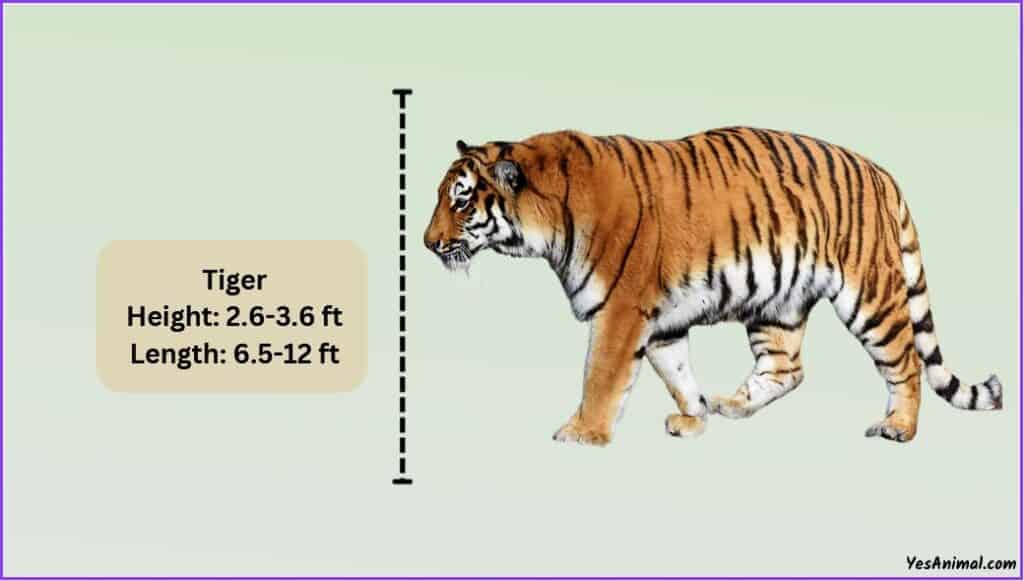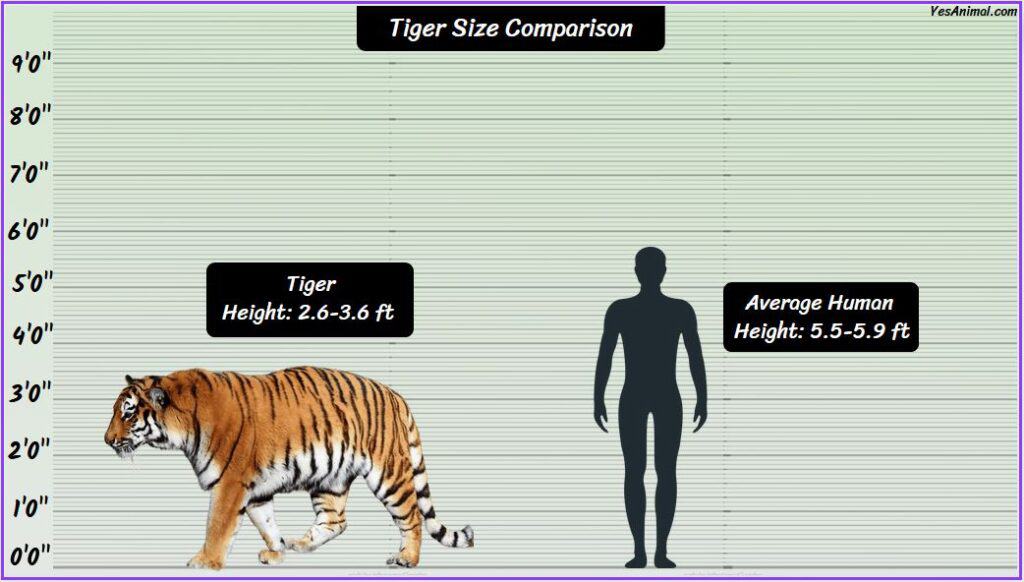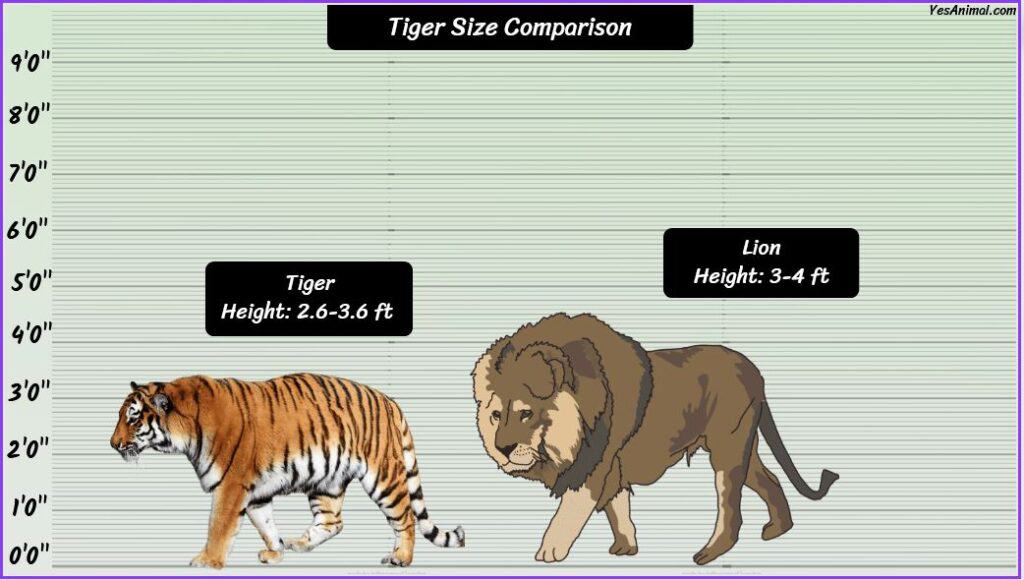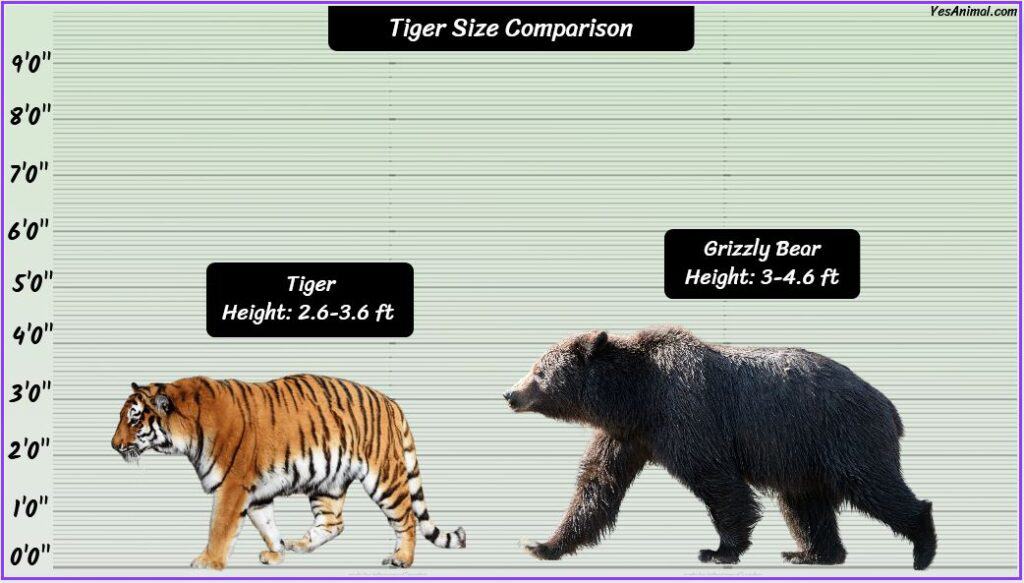Last Updated on April 15, 2024 by Amin Tawar
Tiger Height & Length

Tigers are large, carnivorous cats native to Asia. They are known for their distinctive orange and black striped fur and are the largest wild cats in the world.
Tigers are apex predators, which means that they are at the top of the food chain and have no natural predators of their own.
They are powerful and graceful animals and are known for their strength and hunting powers. However, have you ever wondered what makes tigers so powerful? One of the factors which contribute to their strength is their large size.
Tigers are among the largest cats in the world. Below are the all tiger species with their length and height.
The Allure of Species:
Each tiger species boasts its own size range, a unique melody in the symphony of their diversity:
| Tiger Species | Length Range | Shoulder Height Range |
|---|---|---|
| Amur (Siberian) Tiger | 5.9 – 9.8 ft (1.8 – 3 m) | 2.9 – 3.3 ft (88 – 100 cm) |
| Bengal Tiger | 5.3 – 6.5 ft (1.6 – 2 m) | 2.6 – 3.1 ft (80 – 94 cm) |
| Indochinese Tiger | 5.3 – 5.9 ft (1.6 – 1.8 m) | 2.6 – 2.9 ft (80 – 88 cm) |
| Malayan Tiger | 5.3 – 5.9 ft (1.6 – 1.8 m) | 2.6 – 2.9 ft (80 – 88 cm) |
| Sumatran Tiger | 5.1 – 7.4 ft (1.6 – 2.2 m) | 2.3 – 2.6 ft (70 – 80 cm) |
Size Variations: Size variations in tigers aren’t just dictated by species. Individual factors like:
- Sex: Picture this: just like in many human gatherings, the ladies often bring a touch of elegance. In the tiger world, females gracefully take on a slightly smaller stature compared to their brawny male counterparts across most species.
- Age: Tigers, much like humans, have a growth story to tell. The youngsters embark on a steady journey of vertical conquest, reaching their full-sized glory after a few spins around the sun. It’s the age-old tale of adolescence, just with more stripes.
- Habitat: Tigers in resource-rich neighborhoods, tend to flaunt a larger physique. Meanwhile, those navigating harsher terrains embrace a more streamlined existence. Source
Tiger Weight
As we already know that tigers are one of the largest land animals, tigers have also proved to have powerful muscles and a strong build, which allows them to hunt and kill large prey. Their weight and strength make them one of the huge predators in the food chain.
The weight of a tiger can vary greatly depending on several factors, including its age, sex, diet, and lifestyle.
Tigers are carnivorous animals and primarily feed on large mammals such as deer, wild pigs, and buffalo. They are also known to eat smaller animals, such as rabbits and birds if the opportunity arises.
Due to this, on average, male tigers weigh between 300 and 430 pounds, while females weigh between 250 and 370 pounds.
However, some subspecies of tigers, such as the Siberian tiger, can weigh significantly more, with males reaching weights of up to 660 pounds.
Additionally, the weight of a tiger also depends on its age. Tiger cubs are born small and weigh only around 2 pounds at birth, which is quite lighter than their adult counterparts. 1
| Tiger Species | Weight Range |
|---|---|
| Amur (Siberian) Tiger | 300 – 660 lbs (136 – 300 kg) |
| Bengal Tiger | 220 – 550 lbs (100 – 250 kg) |
| Indochinese Tiger | 220 – 350 lbs (100 – 160 kg) |
| Malayan Tiger | 220 – 330 lbs (100 – 150 kg) |
| Sumatran Tiger | 176 – 264 lbs (80 – 120 kg) |
Factors Affecting Tiger Weight:
- Sex: Females, across most species, are lighter than their male counterparts.
- Age: Young tigers grow steadily, reaching their full weight after several years.
- Habitat: Tigers in resource-rich environments tend to be heavier than those in harsher landscapes. Source
Tiger Paw Size & Teeth Size
In the wild, tigers are skilled hunters and use their powerful jaws and sharp claws to kill their prey. Overall, tigers have large paws and sharp teeth that help them to hunt and kill their prey.
- Paw Length: Tiger paws range from 3.5 to 5.5 inches (9 to 14 cm), comparable to a large human hand.
- Retractable claws: Hidden within the paw pads, tiger claws reach 1.5 to 2.5 inches (4 to 6 cm) in length.
- Powerful pads: Thick, fleshy pads beneath the toes act as shock absorbers, allowing for silent stalking and explosive pounces.
Moreover, if you look at the size of their teeth, tigers have sharp, curved teeth that are adapted for tearing and cutting meat or their caught prey.
A tiger’s mouth is a fearsome arsenal, housing 30 razor-sharp teeth:
- Canines: The undisputed stars of the show, tiger canines grow up to 3 inches (7.6 cm) and are designed for piercing and tearing prey.
- Incisors: Sharp and pointed, these teeth slice through flesh and hold prey while tearing.
- Premolars and molars: These crushing teeth break down bones and sinew, ensuring efficient digestion.
Overall, the paw and the teeth are one of the most crucial parts of a tiger, which makes them powerful and astonishingly good at hunting, which in turn keeps them healthy and fit in size.
Baby Tiger Size
A tiger baby is a young tiger, also known as a cub. Tigers are one of the largest and most iconic members of the cat family. Interestingly, tiger cubs are born blind and are completely dependent on their mother for the first few weeks of their lives.
As they grow, they will begin to explore their surroundings and learn the skills they need to survive on their own. Additionally, with their growing age, they also grow in terms of their overall size. Here’s their complete size breakdown: Source
| Age | Length (inches) | Weight (lbs) | Description |
|---|---|---|---|
| Newborn | 15-18 | 1.75-3.5 | Aww, the newborn phase! Imagine tiny bundles covered in soft fuzz, relying on their mother’s milk. Blind, but oh-so-adorable. |
| 1 week | 18-20 | 3.5-4.5 | Fast forward a week – eyes open, and they’re on a curious exploration mission. Vocalizing and sibling interactions kick in. |
| 2-3 weeks | 20-22 | 4.5-6 | First wobbly steps and playful wrestling debut. It’s like their very own adventurous ballet with newfound senses joining the fun. |
| 4-6 weeks | 22-24 | 6-8 | Mobile and confident explorers now, venturing from the den. Pouncing and practicing hunting skills – the tiger cub Olympics begin! |
| 6-8 weeks | 24-26 | 8-10 | Taste buds awaken to solid food, alongside milk of course. Hunting skills get an upgrade, and playful interactions hit their peak. |
| 3 months | 26-28 | 10-12 | Fully weaned and joining mom on hunts. Survival lessons in full swing – these tiger cubs are on their way to becoming pros. |
| 6 months | 30-32 | 12-15 | Halfway to adulthood! Confidence surges, independence blooms, and hunting skills become a refined art. Tiger cub swagger at its peak. |
| 1 year | 34-36 | 15-20 | Almost there! While not quite full-grown, they’re establishing territories and absorbing wisdom from their ever-wise mother. |
How Big Is A Full-Size Tiger?
Once the baby tigers mature, they reach their full size, that is they rarely grow beyond that particular length, height or weight.
If you are thinking of what exactly is the full size of the tigers and at what age they mature, then it is quite obvious that there is not a single answer.
This is because there are different subspecies and types of tigers that live in different habitats and have varied access to resources.
However, full-grown adult tigers can vary in size depending on the subspecies, but on average, they have a length of around 2-3.6 meters (6.5-12 feet) from the nose to the tip of the tail and a weight of between 200 and 300 pounds.
The largest subspecies of tigers, the Siberian tiger, can reach lengths of up to 3.3 meters (11 feet) and weigh as much as 660 pounds. However, the average size of an adult tiger is typically somewhat smaller than this.
Tiger Size Compared To Human

While it can be quite confusing to visualize and analyze the size of a species without seeing or actually being in contact with it, you can surely compare its size with another known species.
For instance, it is quite rare that we would actually see a tiger from a very close distance, so it is hard to tell exactly how large or small they are. So, what we can do is, compare it with ourselves.
Tigers are much larger than humans, both in terms of weight and overall size. The average full-grown adult tiger has a length of around 2-3 meters (6.5-10 feet) from the nose to the tip of the tail, while the average height of an adult human is around 1.5-1.8 meters (5-6 feet).
In terms of weight, the average adult tiger weighs between 200 and 300 pounds, while the average adult human weighs around 130-170 pounds.
This means that an average adult tiger is at least two times as long as an average adult human and weighs at least 2 times as much.
| Animal type | Height | Weight |
| Tiger | 2.6-3.6 ft | Male: 150 kg (330 lbs) Female:110 kg (240 lbs) |
| Average adult human | 5.5 to 5.9 feet | 132 to 176 pounds (60 to 80 kgs) |
Also Check Out Saber Tooth Tiger Size & Comparison
Tiger Size Compared To Lion

Moving on, one of the closest relatives to a tiger is a lion, so how can we not compare the size of these two species?
Although both tigers and lions are large members of the cat family, tigers are typically bigger.
From nose to tail tip, the average full-grown adult tiger measures about 2-3 meters (6.5-10 feet), while the average full-grown adult lion measures about 1.5-2.5 meters (5-8 feet).
The average adult lion weighs about 330 to 550 pounds, whereas the average adult tiger weighs between 200 and 300 pounds.
This indicates that tigers are slightly longer than lions but lions are on the heavier side. Individual tigers and lions can vary greatly in size, though there is significant size variation within both species.
Additionally, as tigers are quite larger than lions, they are also very agile and aggressive.
| Animal type | Height | Weight |
| Tiger | 2.6-3.6 ft | Male: 150 kg (330 lbs) Female:110 kg (240 lbs) |
| Lion | 3-4 ft | Male: 330 to 550 pounds (150 to 250 kilograms) Female:110–143 kg (240–316 lb) |
Also Check Out Siberian Tiger Size & Comparison
Tiger Size Compared To Grizzly Bear

Next up, is another species of animals, that is quite large and heavy just like tigers, the Grizzly bears. It is difficult to predict who would win in a fight between a grizzly bear and a tiger, but many people would probably give the grizzly bear the advantage due to its superior size and strength.
The biggest grizzly bear ever recorded is as big as a Siberian tiger. As a result, the grizzly bear typically has an advantage in size.
Grizzly bears and Siberian tigers are very similar in size. Contrary to what the last sentence might imply, the Siberian tiger is the largest species of tiger in the world.
They can weigh up to 660 pounds and are 11 feet long and 3.5 feet tall. But at that time, they are the largest. The typical grizzly bear is at least 700 pounds in weight, 10 feet long, and 4 feet tall at the shoulder.
| Animal type | Height | Weight |
| Tiger | Male:2.5 m (8 ft) Female: 2.3 m (7.5 ft) | Male: 150 kg (330 lbs) Female:110 kg (240 lbs) |
| Grizzly bear | Male Height: 1.07 and 1.37 m(3 feet 6 inch and 4 feet 6 inch) Female Height: 0.91-1.12 m(3 feet to 3 feet 8 inches) | Male: 181.4 – 272.1 kgs(400 and 600 lbs) Female:113.3 – 158.7 kgs (250 and 350 lbs) |
Tiger Size Compared To Cow
The last animal to compare with the tiger, is a cow, which is quite different in terms of size and appearance. A cow has a significant size and weight advantage over a tiger, and it is likely that the cow would be able to defend itself effectively against the tiger in a fight.
The average full-grown adult tiger has a length of around 2-3 meters (6.5-10 feet) from the nose to the tip of the tail and a weight of between 200 and 300 pounds, while the average full-grown adult cow has a length of around 1.5-2 meters (5-6.5 feet) and a weight of around 1,000-1,500 pounds. Therefore, on average, cows are significantly larger and heavier than tigers.
| Animal type | Height | Weight |
| Tiger | Male:2.5 m (8 ft) Female: 2.3 m (7.5 ft) | Male: 150 kg (330 lbs) Female:110 kg (240 lbs) |
| Cow | Height: 53.9”-59.8” (137-152 cm) | 450–1,800 kg (1,000–4,000 pounds) |
Conclusion
From the majestic Siberian tiger standing tall to the elusive Amur prowling silently, tigers weave a mesmerizing tale of strength and elegance. Beyond the cold numbers of length and weight, their size becomes a narrative, a poetic ode to their reign as apex predators. It’s not just about dimensions; it’s a living testament to the intricacies of evolution, an artistry shaped by the delicate dance of their paws and the formidable design of their teeth.
And that was everything you need to know about the size of Tiger. I hope this article was informative enough and your queries were answered.
Thank You For Reading!
References And Sources:
- National Geographic: https://m.youtube.com/watch?v=-GTgSPQa9OA
- Save the Tiger Fund: https://savethetigers.org/
- World Wildlife Fund: https://tigers.panda.org/
- Save the Tiger Fund: https://savethetigers.org/
- World Wildlife Fund: http://www.worldwild.org/
Related Articles You May Like